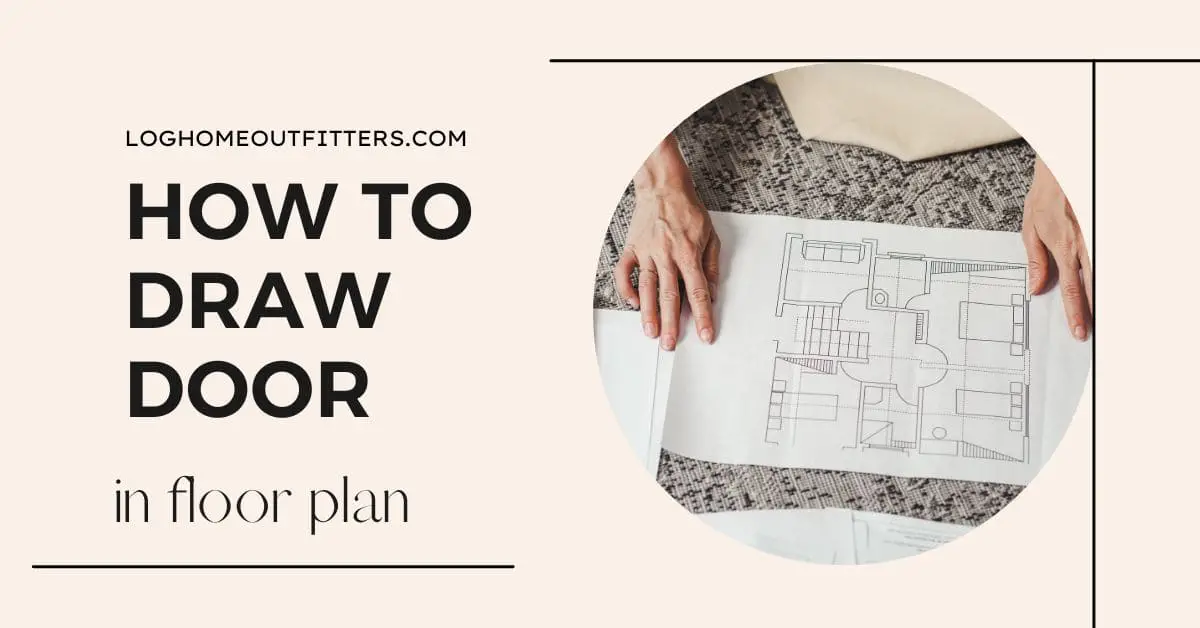I am an professional in creating floor plans, and at the moment I’ll share with you some recommendations on how to draw door in floor plan. As somebody who has labored extensively on this area, I do know that creating an correct floor plan is crucial for any building mission. Some of the crucial parts of any floor plan is the location and design of doorways.
Through the years, I’ve encountered many challenges in drawing doorways on floor plans. I’ve realized by way of expertise that drawing doorways in the suitable location and with the proper dimension is crucial for making a useful and aesthetically pleasing floor plan. I’ve additionally found that there are various several types of doorways to select from, every with its distinctive set of design issues.
Drawing a door in a floor plan could look like a easy job, but it surely requires plenty of consideration to element to get it proper. That is why I am excited to share my data with you at the moment to assist make the method simpler for you. By following the following pointers, you can draw doorways in your floor plan with confidence and accuracy.
So, whether or not you are an expert architect or a DIY fanatic, be part of me as we discover the ins and outs of drawing doorways in your floor plan.
How to draw door in floor plan step-by-step
As an architect with years of expertise within the area, I do know that drawing a floor plan could be difficult, particularly in the case of drawing doorways. Doorways play a vital function in a floor plan as they supply entry between rooms and circulation inside the area. On this weblog put up, I’ll information you on how to attract a door in a floor plan step-by-step.
Step 1: Decide the Door Dimension
Earlier than you begin drawing the door, it’s good to decide the door’s dimension. The usual door dimension is 36 inches extensive by 80 inches tall. Nevertheless, there are numerous sizes accessible, relying on the room’s necessities. As an example, a toilet door will probably be smaller than a bed room door. Due to this fact, it’s important to resolve the dimensions of the door earlier than continuing with the drawing.
Step 2: Decide the Door Swing
Upon getting decided the door dimension, the subsequent step is to find out the door’s swing. A door can swing inwards or outwards, relying on the room’s structure. To find out the door swing, draw an arc utilizing a compass from the middle of the door opening. The arc must be 90 levels for an inward swing and 270 levels for an outward swing.
Step 3: Draw the Door Opening
After figuring out the door dimension and swing, it is time to attract the door opening. The door opening must be barely bigger than the door dimension to permit for clearance. Draw a rectangle for the door opening, with the arc indicating the door swing. Make sure that the rectangle is centered within the wall and that there’s sufficient area across the door opening.
Step 4: Draw the Door
The subsequent step is to attract the door itself. Draw a rectangle that matches the door dimension, together with any ornamental options similar to panels or glass. Then, draw a horizontal line throughout the door, indicating the peak of the doorknob. Lastly, draw two vertical traces, indicating the perimeters of the door.
Step 5: Point out the Door Swing
To point the door swing, draw an arc from the middle of the door opening to the doorknob’s peak. This arc ought to match the arc drawn in Step 2. You can even point out the door swing by drawing an arrow pointing inwards or outwards.
Step 6: Add Labels
To make sure that the floor plan is obvious and straightforward to grasp, add labels indicating the room’s title and the door’s sort. For instance, if the door results in a bed room, label it “Bed room Door” or “BDRM.” Additionally, point out if the door is a pocket door, sliding door, or hinged door.
How are doors shown on blueprints?
I do know that doorways play a vital function within the structure and performance of a constructing. When creating blueprints, it is important to precisely depict the doorways’ location and sort to make sure the constructing’s security and performance. On this weblog put up, I am going to clarify how doorways are proven on blueprints
Doorways on blueprints are sometimes proven as an oblong opening with a logo indicating the door’s swing path. The opening is often drawn with a dashed line to differentiate it from strong traces indicating partitions.
The door’s swing path is indicated with an arc extending from the middle of the opening to the facet the place the doorknob is situated. The arc is drawn at a 90-degree angle to the opening’s edge, representing the door’s swing path.
As soon as the opening and swing instructions are indicated, the door’s dimensions and sort are proven. The scale are sometimes proven as a width and peak measurement, whereas the door sort is indicated with a logo or abbreviation.
Frequent door sorts embrace hinged doorways, sliding doorways, pocket doorways, and double doorways. These symbols are often positioned subsequent to the door opening and may range relying on the blueprint’s scale.
Along with indicating the door’s location, dimensions, and sort, it is also important to label the door on the blueprint. Labels are sometimes positioned subsequent to the door and point out the room title, the door sort, and every other related details about the door’s perform.
Total, doorways on blueprints are proven with a mixture of symbols, measurements, and labels to precisely depict their location and sort. Following these pointers ensures that the constructing’s structure and performance are precisely represented on the blueprint
How are doors represented in elevation?
Doorways in elevation are represented as openings within the constructing’s exterior partitions. The opening is usually rectangular and is drawn with a strong line.
The scale of the opening must be proportional to the dimensions of the door and must be clearly labeled with the door’s dimensions. If the door has any distinctive design parts, similar to glass panels or ornate handles, these also needs to be included within the drawing.
The door’s swing path can also be vital to point out within the elevation drawing. The swing path is the best way the door opens, both in the direction of or away from the viewer.
The swing path is indicated with an arc or curved line drawn over the door opening, with an arrow indicating the path wherein the door swings. The swing path must be proven for all doorways on the elevation drawing.
If the door is an element of a bigger meeting, similar to a storefront or curtain wall system, it must be indicated within the drawing. The door’s body and different elements must be represented with dashed traces to distinguish them from the strong traces used to characterize the door opening.
Lastly, it is vital to point the peak of the door within the elevation drawing. The door’s peak is usually represented with a vertical line drawn from the floor to the highest of the door opening. This line must be labeled with the door’s peak in ft and inches.
What does F mean on floor plans?
I perceive that studying floor plans could be difficult, particularly for many who should not accustomed to the symbols used. One image that usually causes confusion is the letter “F” on floor plans. On this weblog put up, I’ll clarify what the letter “F” means on floor plans
The letter “F” on a floor plan is usually used to point the floor stage or floor peak. That is particularly vital in multi-story buildings the place it’s essential to know which floor a room or area is situated on.
The letter “F” is used at the side of a quantity to point the precise floor stage. For instance, if a floor plan exhibits “F1,” it signifies that the area is situated on the primary floor of the constructing.
It is vital to notice that the letter “F” will not be the one image used to point floor ranges on floor plans. Relying on the constructing’s design and the architect’s desire, different symbols similar to numbers or letters could also be used. For instance, some architects could use the letter “L” as a substitute of “F” to point floor ranges.
Along with the letter “F,” different symbols are generally used on floor plans to point numerous options and parts of the constructing. For instance, traces and arrows are used to point the path of doorways and home windows, whereas circles and squares are used to point lighting fixtures and electrical shops.
Conclusion
In conclusion, drawing a door in a floor plan requires cautious consideration of the door dimension, swing, and sort. By following the above steps, you’ll be able to simply draw doorways in your floor plan and create a transparent and correct illustration of the area.
Keep in mind to label the doorways appropriately to keep away from confusion and make it simpler for others to grasp the floor plan. With observe, you’ll be able to enhance your drawing abilities and create professional-grade floor plans.
FAQs
What tools do I need to draw a door in a floor plan?
To attract a door in a floor plan, you will want a ruler, a pencil, and a floor plan template. You may additionally wish to use an eraser and a scale ruler to verify your measurements are correct.
What are some tips for drawing a door in a floor plan?
When drawing a door in a floor plan, you should definitely measure the area precisely and use a scale ruler to make sure that your drawing is to scale.
You may additionally wish to use a straight edge to create straight traces, and to label the door with the suitable dimensions.
How can I learn more about drawing floor plans?
There are various sources accessible on-line for studying how to attract floor plans, together with tutorials, movies, and software program instruments.
You may additionally wish to think about taking a course or workshop on architectural drafting or design, or consulting with an expert architect or designer for steerage and recommendation.




